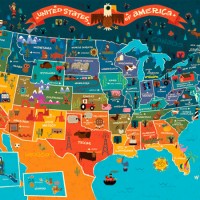Midsomer Murders is a long-running English detective series produced by ITV, based upon the characters created by Caroline Graham. Chief Inspector Barnaby and his team solve crimes in this (fictional) county of small villages and lovely rural landscapes. In Midsomer people ride their bicycles past thatched-roofed houses to attend fetes, go to Church of England Sunday services, and relax in the evenings at the local pub - it's all very peaceful, except of course for all the murders, difficult though not impossible to solve. In 2011 the show's … [Read more...]
Things I do not understand about the ticket-resale debate
The Guardian reports that next week Professor Michael Waterson will release a UK government commissioned report on the regulation of ticket resale. I'm glad to hear it, because it might shed some light on an issue which the press seems to find simple - touts are ripping off consumers and there ought to be a law! - but which I find very complex. Here are three questions I hope it answers. I don't have the answers - these are real questions! First, what is the presenting problem for public policy? If it is that sometimes resellers use … [Read more...]
Pricing for the sensible arts consumer
At flux[x] Tom Whitwell has a very interesting read on pricing, and the psychology behind how we make choices when confronted with varying sets of prices. I highly recommend it. He uses examples ranging from newspaper paywalls, Netflix and phone packages, wine, and experimental evidence regarding beer. In short: "Prices are a shortcut to our most sensitive emotional responses." Sometimes, yes. But. I think it is important for arts administration practitioners and students to be careful not to see all pricing strategies as ways to mine the … [Read more...]
Teaching controversial topics in class, and guns
At the Chronicle of Higher Education, Erik Gilbert writes that academics should calm down about college campuses being moved by legislation to allow the concealed carry of firearms. He concludes: People who are terrified by the prospect of a few students who have gone though background checks bringing concealed weapons to class are being just as irrational in their risk assessment as people who won’t leave the house unarmed. Speaking of flawed risk assessment, suggestions that Texas faculty avoid teaching controversial topics are predicated … [Read more...]
No more pocket versions of To Kill A Mockingbird
The estate of Harper Lee has decided to end its relationship with Hachette publishers, which was licensed through HarperCollins to produce a mass-market paperback edition of To Kill A Mockingbird. HarperCollins will continue to produce a trade paperback version. See these reports from The New Republic and The Guardian. Since the author only died this year, under current law the novel would not enter the public domain until 2086, though the duration of copyright tends to get longer rather than shorter with each revision, and so even that date … [Read more...]
Selfies in the museum, Victorian edition
Pacific Standard reports that "Surprised museum researchers find many visitors snap photographs of themselves with the masterpieces." I'm not sure which researchers are actually surprised by this. But by coincidence I am now reading John Carey's The Intellectuals and the Masses: Pride and Prejudice among the Literary Intelligentsia, 1880-1939. He cites Thomas Hardy's notebooks from the 1880s, and the author's visit to the British Museum, where he saw (p. 24): ... crowds parading and gaily traipsing round the mummies, thinking today is for … [Read more...]
Time has come today
At the Washington Post, Philip Kennicott looks at changes in how people work and play, and implications for cultural organizations, especially museums. I'm not sure all of the claims made by people he cites add up. First, from Elizabeth Merritt, of Center for the Future of Museums. Kennicott writes: A transformation in how we work, says Merritt, will affect both how museums employ people and how they may need to change to attract new audiences. “Increasingly we see people who had regular full-time jobs who are now picking up pieces of … [Read more...]
Is there a Canadian cultural policy crisis?
At the Globe and Mail, Kate Taylor writes: The policy tools that have protected and nurtured Canada’s cultural industries since the 1970s are unknown to transnational distributors of foreign content – that would be Google, YouTube and Netflix – while Canadian consumers are increasingly sidestepping the domestic distributors who, whether by inclination or by regulation, produce Canadian content. How big a crisis? A new report prepared by the research firm Nordicity for the annual Digital Media at the Crossroads gathering held at the … [Read more...]
Dynamic pricing and price discrimination are not the same thing
But a recent article in The Economist (!) confuses the matter. Dynamic pricing occurs when sellers adjust prices on a frequent basis to account for varying shifts in demand, or limitations in supply. Uber raises fares when demand spikes upward and drivers are scarce; sports teams cut prices for tickets for the final games in a season when it becomes clear the team will not qualify for the playoffs; airlines raise or lower prices to maximize revenue from scheduled flights; theatres lower prices for shows, or specific dates for shows, where … [Read more...]
Local, state, federal: public funding for the arts in the U.S.
At the Atlantic, Andy Horwitz asks 'Who should pay for the arts in America?' He is specifically asking about nonprofit arts, whose funding comes from paying customers, donors and other sponsors, and the public sector. He observes: The current state of the arts in this country is a microcosm of the state of the nation. Large, mainstream arts institutions, founded to serve the public good and assigned non-profit status to do so, have come to resemble exclusive country clubs. Meanwhile, outside their walls, a dynamic new generation of artists, … [Read more...]










